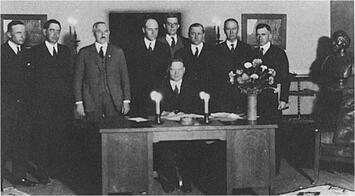
Part one of this essay showed how the political tradition of Alexander Hamilton, Henry Clay, and Abraham Lincoln gave rise to the successful spread of American civilization into the forbidding region between the 98th parallel and the Pacific Coast Ranges. Part two of this essay will bring the story of America’s western cities up to the present, looking at how federal policies combined with the West’s distinctive form of capitalism to create the nation’s most modern metropolitan megaregion.
Federal water “reclamation” activities started small, based on the premise that Washington, D.C., would only pursue projects that could recoup their construction costs through water revenues from local farmers. It soon became clear that the premise of quick payback wasn’t going to work, and Congress amended the law to widen the range of federal activities in 1910 and many times thereafter. The fast-expanding Bureau of Reclamation shifted to paying for dams through electricity sales and, when those proved insufficient to support America’s burgeoning ambitions in the West, through appropriations from the Treasury’s general account.
After seven Western states agreed on how to apportion the Colorado River’s water in a 1922 compact, Congress authorized the Hoover Dam, the largest dam in history to that time. Under Franklin Delano Roosevelt, another Hamiltonian, the bureau entered a golden age lasting until the 1970s. Its initiatives included more than a thousand major dams in the Missouri and Columbia River watersheds, along the Colorado, in California’s Central Valley, and in central Arizona.
Building the West’s hydraulic infrastructure was a remarkable technical achievement. Among the many wonders achieved by the Bureau of Reclamation was lifting water more than 3,000 feet over the Tehachapi Mountains to support Los Angeles and diverting all the Colorado’s water to human uses.
But, perhaps ironically, the federal campaign to promote agriculture in the West was at best modestly successful. Federal irrigation projects never supported more than a small number of farmers, even though agriculture came to take up more than 80 percent of all diverted Western water by the 1970s. And the Bureau had to sell its water far below cost to make even these tenuous farming beachheads viable.
One problem: There simply wasn’t enough surface water in the West to fulfill America’s agricultural dreams. John Wesley Powell, explorer of the Grand Canyon and father of federal engagement with Western water challenges, had warned as much in the 1880s, but Western boosters had ignored him.
To make matters worse, irrigation invariably increases the salinity of surface water over time. More and more Western acreage has gone out of production for this reason despite enormous federal investments in desalination infrastructure.
Read the rest of this piece at The American System.
J. H. Cullum Clark is director of the George W. Bush Institute–Southern Methodist University Economic Growth Initiative and an adjunct profes-sor of economics at Southern Methodist University in Dallas, Texas. He is coauthor of The Texas Triangle: An Emerging Power in the Global Economy (Texas A&M University Press, 2021).
Photo: 1922 Colorado River Compact signing, Bureau of Reclamation via Flickr under CC 2.0 License.












